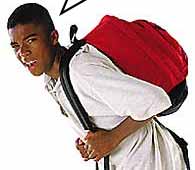

Weighing In On Backpack Safety
This section is compiled by Frank M. Painter, D.C.
Send all comments or additions to: Frankp@chiro.org




Tips for toting school gear without physical injuries
Mark D. Widome,MD
Today Show Contributor
Is the back a good place to carry books?
Yes. The vast majority of students in elementary school, high school, and on college campuses opt for backpacks, as opposed to hand-held book bags. It is not only a fashion statement, but a logical choice for a way to carry a heavy load.
Children's backs are both strong and flexible. Remember that the spine is not a single bone, but rather it is a stack of bony doughnuts, with the spinal cord running up and down through the central spinal canal. The bones of the spine - or vertebrae - don't simply sit on top of one another, but rather fit neatly together, like a loose-fitting three-dimensional puzzle, allowing us to bend forward, backward, or to either side. Additionally, there are soft "spongy" discs between each of the vertebrae; these serve as shock absorbers, adding to the spine's strength and flexibility.
The vertebrae remain neatly stacked when we walk, run , jump, swim, do gymnastics - and when we carry a backpack - because strong ligaments and supporting muscles hold everything in place. These bones, ligaments, muscles, and "shock absorbers" are usually strong enough and large enough to carry geometry, Spanish, U.S. history, and spiral notebooks. But they can't carry everything.
How much weight, and where to carry it
Muscles and ligaments let their owners know when they are asked to do too much. The results of carrying too much weight for too long is muscle soreness and strained ligaments, causing back discomfort anywhere from the shoulders to the lower back. A recent survey of 100 doctors conducted by the American Academy of Orthopedic Surgeons revealed that more than half of these specialist had seen kids with back or shoulder pain related to backpacks.
While larger, stronger backs can carry more weight, there seems to be no clear consensus about how much weight is too much. It depends in part on how efficiently the weight is carried - choosing a good backpack and using it correctly - and we'll get to that in a minute. But many of the surveyed physicians felt that carrying about 20 percent of a child's body weight on her back should be the limit.
I think 15 percent of a child's weight is a good guideline for the maximum weight of a child's backpack. That would suggest that an 11-year-old who weighs 80 pounds should limit the backpack to 12 pounds. While a few more pounds probably wouldn't hurt a strong child, the bottom line is whether a given load is causing a particular child discomfort. In general, your body is pretty good at telling you when you are asking it to do too much.
Can carrying too much weight cause serious problems?
Probably not. There is no evidence that carrying a backpack, or even carrying a backpack that is too heavy can cause any serious back problems: curvature of the spine, other spinal deformities, or even poor posture. Improper use of a backpack can cause muscle strain, and muscle strain hurts, but it heals, particularly in children, where almost everything heals more rapidly than in adults.
What if my child has back pain?
Pain across the shoulders or diffusely in the lower back at the end of the school week may well be due to carrying a backpack that is too heavy. A good sign that the backpack is the cause is that the discomfort will be gone or nearly gone by Monday morning. However, it is possible to have a more serious back problem and incorrectly attribute the discomfort to the backpack.
Back pain in a child or teen-ager that is persistent for more than three days - particularly three days of having given up the heavy backpack - deserves a least a call to the child's physician. Pain and/or tenderness in one discreet area of the back deserves particularly close attention to make sure that it doesn't represent an infection or a stress fracture. Stress fractures are particularly likely in young people who are gymnasts, football players, or wrestlers: activities that put extra stress on the bones and ligaments of the If your child's back pain is associated with fever, inability to bend in any direction, pain shooting down the buttock or back of the leg, or a limp, then don't assume that it is muscle strain from the backpack. Get the opinion of your pediatrician. The same holds true if the pain is persistent or recurrent. But for the shoulder and back pain that is transient and goes away over the weekend, the real solution is to lighten the load.
What to look for in a backpack
Backpacks come in lots of styles with lots of features, some functional and some cosmetic. For comfort, look for a backpack with wide, heavily padded shoulder straps that are easy to adjust. Built in back supports, "lumbar pillows," and waist and side straps may be useful in keeping the backpack correctly close up against the back and keeping the weight evenly distributed. Backpacks with separate compartments also allow to evenly distribute the load. The best way to evaluate a backpack is to try it on for comfort. Put a few books in it to see how it feels and fits when "loaded."
Using backpacks correctly
Backpacks should be worn over both shoulders, otherwise, a single shoulder is being asked to carry the weight that should be shared by both shoulders and the back. The shoulder straps should be adjusted so that the pack is close against the back. For heavier loads, a "hip strap" can distribute some of the weight from the shoulders to the hips. Keep the heaviest items closest to your back (put them in the pack first), and evenly distribute the load on the right and left.
... and using them safely
According to the Consumer Product Safety Commission, there were over 12,000 visits to emergency rooms in 1998 for backpack-related injuries to 5- to 18-year-olds. It is interesting to speculate about the nature of these injuries. It is also interesting to note that more and more schools across the country are "banning" backpacks from hallways and classrooms. School officials cite overcrowding and safety concerns as reasons for insisting that the backpacks stay in the lockers during the school day. With heavier and bulkier backpacks in ever more crowded hallways and classrooms, one wonders how often a child will turn quickly and swing his 20-pound backpack into a fellow student. In classrooms, and especially in labs, there is often no place to put the backpacks except in the aisles, causing kids to trip and fall, and raising serious concerns for the fire marshal.
Students claim that they need their backpacks to carry books to class because they don't have time to go to their lockers between classes. But if backpacks are to be in the classroom, it seems reasonable to insist that children carry in their packs only what they need - to conserve both weight and space. Backpacks need not contain snacks, Snapple, athletic equipment, CD players, and other nonessentials that add to their bulk. Smaller backpacks should fit under seats and desks, leaving aisles clear.
And finally, backpacks should contain no loose or dangling cords, strings, key chains, or pieces of clothing. Catching a cord in a closing door could make you trip and fall. Catching a cord in a school bus door could be tragic.
When not to use a backpack
Backpacks are for walkers and hikers. When children are on wheels - bikes, skates, or boards, filled backpacks can be hazardous. Packs make kids top-heavy, less stable, less able to maneuver, and more likely to fall. In automobiles, heavy backpacks can become flying missiles in crash; keeping on the floor or throwing them in the trunk makes sense. Kids should relinquish their backpacks before using swings, slides, or other playground equipment.
More information about backpacks may be found at Consumer Reports Online, for Kids.
Copyright 2000 Mark D. Widome, M.D. Dr. Widome is a general pediatrician and professor of pediatrics at Penn State's College of Medicine in Hershey, Pa. Dr. Widome writes frequently on topics of interest to parents.

Return to BACKPACKS


| Home Page | Visit Our Sponsors | Become a Sponsor |
Please read our DISCLAIMER |
